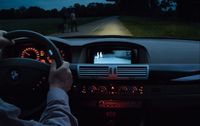Automotive Night Vision Moving Toward the Mainstream
NEW YORK--Automotive night vision systems are in their infancy – again. After GM and then Toyota launched versions of the technology in the early part of the decade, the initial excitement faded away until last year when BMW and Mercedes rolled out two new applications. A new study from ABI Research reveals that night vision technology may have a more promising future when linked to the development of other camera-based safety systems.
“Integrating the ability to see better at night into the driving process is a huge challenge,” says senior analyst David Alexander. “But the biggest obstacle to opening up the mass market is cost.”
Until now, the primary goal of a night vision system has been to deliver an enhanced image to the driver, who then has to interpret the extra information. With the advent of obstacle detection via machine vision, it is soon going to be possible for the vehicle to provide the driver with specific warnings of potential problems.
“Honda’s system that is available today, but only in Japan, is the first generation of an ‘intelligent’ night vision function,” says Alexander. “But the cost is much too high for large volume sales. Use of the underlying object detection and identification technology from other camera-based applications could lead to a new category of night vision capability that is both low cost and easy for drivers to use.”
As functionality improves and image processing technology matures, the long term future for night vision systems is positive. Market interest could bode well for Tier 1 system developers such as Autoliv, Bosch, Hella, Siemens, and Valeo, but positive feedback from the first purchasers of the latest generation of the technology is needed to deliver strong demand for the current applications.



